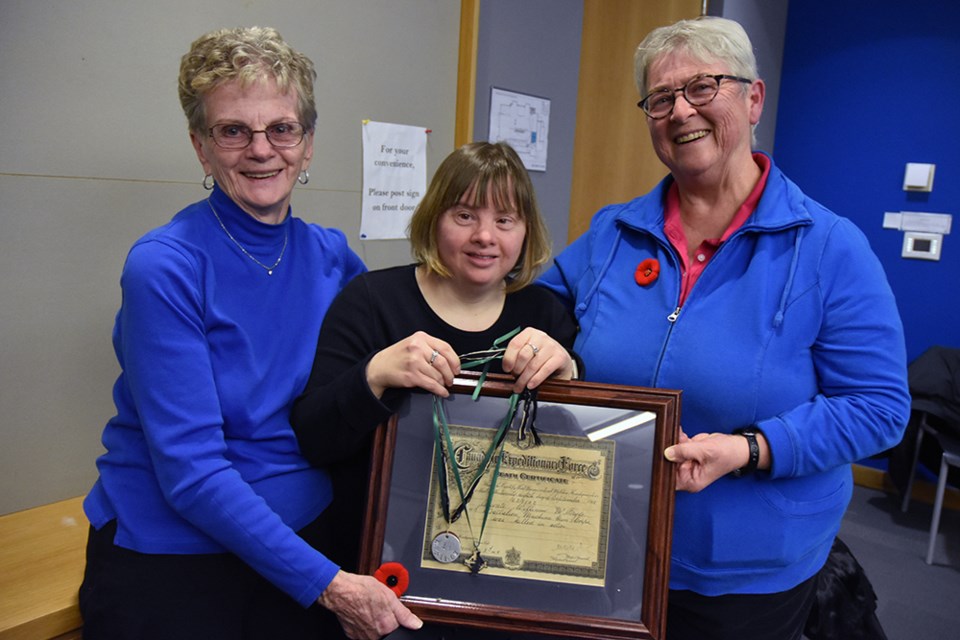Violet Mizzoni and her daughter, Jenny, had to rush to be on time for the Remembrance Day ceremony at the cenotaph on Nov. 11 in Bradford West Gwillimbury.
They brought along a treasured link to the past — the death certificate of Pt. William McBryde, killed in action on Sept. 28, 1918, along with his dog tags and the Memorial Cross delivered to his next of kin.
“He was my grandmother’s first cousin,” said Violet. But that was all she knew. There were no family photos, no details of his service, no information on where he, like so many other Canadians who gave their lives in the First World War, was buried.
A chance meeting with Jan Coward that day at the cenotaph changed everything. Coward has been researching the veterans of First World War who came from the South Simcoe area — combing through the available records to create a database listing everything from attestation and enlistment, to cause of death. She promised to extend her research to include McBryde.
On Nov. 24, Coward spoke to the BWG Local History Association, providing details of local First World War veterans who made the ultimate sacrifice, especially during the period from August to Nov. 11, 1918, known as the Hundred Day Offensive.
Although McBryde enlisted in Vernon, B.C. with the 47th Battalion, “his family now lives in Bradford,” Coward noted, and he died on Sept. 28, within the window of the 100 days.
In fact, McBryde transferred from the 47th to the 4th Battalion machine gun corps just three weeks before he was killed in action, Coward found. He was buried in Raillencourt Community Cemetery Extension in France. He was only 23 at the time of his death.
Coward provided details of the service and deaths of Bradford West Gwillimbury’s First World War veterans, including where they are buried, although some have no known final resting place. Most were in their early 20s when they died.
James Edward Cassells, a private with the 2nd Battalion was killed on Aug. 8, 1918 — the first day of the offensive — when he was hit by a piece of shrapnel. He is buried in Hangard Wood British Cemetery in Corbie, France.
Earnest Cousins (changed to ‘Ernest’ in the records) was killed on Aug. 8 while serving with the 15th Battalion. He was killed by a bullet in the head, and is buried in the Demuin British Cemetery in France.
Pt. Edgar Stephens (‘Stevens’ on the memorial plaque) was killed in action on Aug. 8, while serving with the 157th Overseas Battalion. He was buried at Villers-Bretonneux, France.
Sgt. Wallace McCann was killed in action on Aug. 8, cut down by machine gun fire. His resting place is “known unto God,” said Coward, like nearly one-third of the 60,000 Canadians killed in the First World War. His name is inscribed on the Canadian National Vimy Memorial.
Fred Edwards, while on the Bradford memorial plaque, was largely unknown before Coward began her research. She discovered that his will was made by Bradford lawyer T.W.W. Evans, and that he was listed in the 1911 census as a farm laborer. Edwards was severely wounded by an enemy shell on Aug. 8, 1918, and died of infection six weeks later, at the age of 29.
“There were no antibiotics in World War I,” noted Coward. She discovered that he was buried in Norwich Cemetery in England, where he had family. His brothers Sidney and Walter were also killed earlier in 1918, in March. Their names are inscribed on his stone.
Fred Mooney, wounded Aug. 9 and died Aug. 10, was buried at Viller-Bretonneux Cemetery.
Cpl. William Spence, killed Sept. 27 while leading his gun crew forward in an attack on an enemy position, was awarded the Military Medal for bravery in the field. He was buried in Quarry Wood, Sains-les-Marquion, France.
Pt. Dalton Gosnell, 177th Battalion, wounded June 19, died of his wounds in a Rouen hospital on Aug. 10. He is buried in France.
Not every name can be traced. “Some are a mystery,” Coward said.
She said she used every available record, including newspaper archives and Tweedsmuir histories to find information and bring the veterans from names written in bronze to real people.
Some were British Home Children, who left indentured labour to serve. Often she found that many family members would enlist — “two, three, four brothers,” as well as fathers, uncles and cousins. “There’s hardly ever just one name.”
Coward’s research has led to several changes and additions to the Canadian Virtual War Memorial, including the addition of McBryde.
“We just made it to the remembrance service and lo and behold, look what came of it,” said Violet Mizzoni, promising to share the information, to “make sure the next generation appreciates what the soldiers did for us all.”
Coward would like to see a virtual war memorial on the Bradford West Gwillimbury Public Library website, where local family members could share details, as well as digital images, and preserve the memory of their veterans.
“It would flesh out a little more of a picture of what their life was like,” she said.
“It’s been 100 years since that war, and today I feel that I am right there,” said history association member Mikki Nanowski. “Thanks to Jan, these veterans are not going to be forgotten.”





